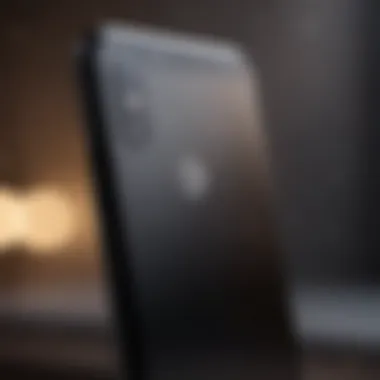Understanding Refurbished Phones: An In-Depth Guide


Intro
The rising interest in technology has led to an increase in options available in the market, particularly when it comes to mobile devices. Among these options, refurbished phones have gained significant attention. This section aims to provide a comprehensive overview of refurbished phones, their definition, and relevance in today's consumer landscape.
Overview of Refurbished Phones
Refurbished phones are pre-owned devices that have undergone a series of inspections, repairs, and refurbishments to make them functionally equivalent to new units. They typically come from customers who return phones due to dissatisfaction, upgrades, or defects.
Key Features
- Quality Assurance: Refurbished devices often go through rigorous testing to ensure they meet specific performance standards.
- Warranty: Many retailers provide a limited warranty on refurbished phones, offering consumers some peace of mind.
- Cost-Effectiveness: One of the main attractions is the reduced price in comparison to new devices.
Purpose and Benefits
The primary purpose of refurbished phones is to provide an affordable alternative for consumers who need a reliable device without paying full price for a new one. Some benefits include:
- Environmental Impact: Purchasing refurbished devices helps reduce electronic waste, contributing positively to sustainability efforts.
- Access to Premium Models: Many consumers who may not afford latest models can access these through refurbished options.
Definition of Refurbished Phones
Understanding what constitutes a refurbished phone is esencial for making informed decisions in the tech market. Refurbished phones are devices that have been returned to the manufacturer or retailer, often due to issues such as defects, dissatisfaction, or minor damage. These phones undergo various assessments and repairs before being resold, hence their classification as refurbished rather than merely used. By clarifying this definition, consumers can differentiate between options available in the market and understand potential value.
What Constitutes a Refurbished Phone
A refurbished phone typically undergoes a series of steps after it is returned. The key components that classify a phone as refurbished include:
- Quality Inspection: After return, phones go through a thorough inspection process to determine what repairs are needed. This includes checking all hardware and software functionality.
- Repairs and Replacements: If any components are found to be faulty or damaged, they are repaired or replaced. This can involve anything from screen repairs to battery replacements.
- Software Restoration: The device is reset to factory settings, and any outdated software is updated. This ensures a smooth user experience when the phone is sold again.
- Packaging and Marking: Refurbished phones are often packaged differently compared to new devices and are usually marked clearly to indicate they are refurbished. This transparency is important for consumer trust.
The end result is a device that offers a level of reliability comparable to new models, but at a lower price. Quality assurance is vital in this process, helping to eliminate consumer doubts about buying refurbished.
Refurbished vs.
Used: Key Differences
The terms ‘refurbished’ and ‘used’ often lead to confusion. However, understanding their differences can impact consumer choices significantly.
- Condition: Refurbished phones are restored to a state that meets specific quality standards. Used phones, on the other hand, may show varying degrees of wear and tear, as they are sold as-is without guarantees on quality.
- Warranty: Refurbished devices often come with some form of warranty, providing a safety net for buyers. Used phones usually lack such guarantees, which means buyers assume more risk.
- Testing and Repairs: Refurbished phones undergo rigorous testing and might be repaired to resolve specific issues. Used phones may not have undergone any testing or repairs, making their reliability uncertain.
- Price Range: Though both options are typically cheaper than new devices, refurbished phones maintain a more stable price point due to their tested and restored condition, whereas used phones can vary greatly in price depending on their condition and seller.
The distinction between refurbished and used phones is significant, as it aids consumer awareness regarding warranties, reliability, and overall value.
In summation, the definition of refurbished phones is crucial in guiding consumers through the fragmented landscape of mobile technology. Understanding this concept can lead to better financial decisions and more satisfactory purchasing experiences.
The Refurbishing Process
Understanding the refurbishing process is vital for grasping what makes refurbished phones a worthwhile investment. The quality of the devices greatly depends on how they are returned, inspected, repaired, and ultimately prepared for resale. This section sheds light on these steps, emphasizing both the benefits and considerations for consumers. A thorough refurbishing process leads to enhanced reliability, enabling customers to select a device that meets their needs without incurring significant costs.
Quality Assessment After Return or Trade-In
Quality assessment is the first step in the refurbishing process. When a phone is returned or traded in, it undergoes an inspection to determine its condition. Technicians evaluate the device for any physical damages, such as cracks or scratches, and check internal components for operational issues. This rigorous assessment ensures that only devices meeting specific standards move forward in the refurbishing process.
Key aspects of quality assessment include:
- Functional Testing: Evaluating the phone's primary functions, like calling, texting, and internet usage.
- Battery Health: Checking the battery's capacity to ensure it holds a charge.
- Cosmetic Condition: Assessing the outer appearance of the device for aesthetic blemishes.
Consumers should know that a reliable evaluation forms the backbone of a good refurbishment. A thorough quality check can significantly reduce the initial risks of buying a refurbished phone, offering peace of mind when making a purchase.
Repair and Replacement Procedures
Once the quality assessment is complete, any necessary repairs and replacements commence. This step is crucial, as it can transform a device with minor flaws into a fully functional and aesthetically pleasing product. Here, technicians will handle various tasks, ranging from simple fixes to comprehensive overhauls.


Common repair and replacement procedures can include:
- Screen Replacement: Fixing a cracked or broken screen enhances usability and aesthetics.
- Component Replacement: Old or malfunctioning parts, such as cameras or charging ports, are swapped out with new ones.
- Cleaning: Ensuring that the device is free from dirt or residual marks to improve its overall look.
The attention to detail during this stage determines the longevity and performance of refurbished phones. Careful repairs can yield devices that often perform as well as their brand-new counterparts, giving consumers excellent value.
Software Updates and Testing
The final step in the refurbishing process involves updating the software and thorough testing. Outdated operating systems or applications can lead to security vulnerabilities and poor performance. Therefore, technicians ensure that each refurbished phone receives the latest software updates as part of the refurbishing process.
Key tasks in this stage include:
- Operating System Updates: Installing the latest version of the operating system to enhance functionality and security.
- App Testing: Ensuring pre-installed applications work seamlessly.
- Factory Reset: Restoring the phone to its original settings, providing a clean slate for the new user.
Completing this step guarantees that the refurbished phone meets current standards, ultimately leading to better performance and user satisfaction. The attention given to software updates is essential for customer peace of mind, making the purchase of a refurbished phone a more attractive option.
A detailed refurbishing process not only ensures product quality but also enhances customer confidence in refurbished phones.
Market Landscape of Refurbished Phones
The market landscape of refurbished phones is a crucial aspect of understanding its overall appeal and viability. With technology evolving at a rapid pace, consumers find themselves in a dilemma between affordability and advanced features. This section provides insights into the current trends and major players in the refurbished phone market, emphasizing their significance for potential buyers.
Trends in Consumer Electronics
Consumer electronics are witnessing a notable shift towards sustainability and affordability, and refurbished phones epitomize this trend. Many customers are increasingly conscious about the environmental impact of electronic waste. Thus, opting for refurbished devices emerges as a responsible choice.
Recently, brands like Apple and Samsung have promoted their refurbished models, creating further awareness and acceptance.
- Sustainability: Customers are gravitating towards choices that reduce electronic waste.
- Affordability: There is a growing awareness that high-quality technology can come at a significantly reduced price.
- Functionality: Technological advancements make older models still relevant, attracting users who need standard features but without premium pricing.
These factors contribute to the expanding popularity of refurbished phones, aligning consumer preferences with broader market trends.
Prominent Players in the Refurbished Phone Market
The refurbished phone market features several notable companies that play crucial roles in shaping the consumer experience. These players ensure that customers find reliable products backed by assurance and credibility.
- Apple: Apple's refurbished program offers quality assurance with verified reliable devices, often at lower prices than new models.
- Samsung: Samsung also provides refurbished options, enhancing their sustainability image and attracting budget-minded consumers.
- Best Buy: This well-known retailer offers a selection of certified refurbished phones with warranty options, appealing to those who prefer established brands.
- Back Market: A dedicated marketplace for refurbished electronics, Back Market has built a reputation for quality and veracity in product reviews.
The growing interest in refurbished phones is not merely about saving money; it reflects a cultural change towards mindful consumption.
These companies define quality assurance and help navigate the refurbished landscape, fostering a market that informs and empowers consumers making purchasing decisions.
Advantages of Choosing Refurbished Phones
Understanding the advantages of refurbished phones is key for consumers who wish to make informed choices. In today's market, the rise of refurbished devices offers an alternative to purchasing brand new models. The reasons for this shift are multi-faceted, encompassing financial implications, environmental considerations, as well as reliability and performance insights. Below, each of these elements contributes to a broader understanding of the advantages associated with refurbished phones.
Cost Savings Compared to New Models
One of the most compelling reasons to choose refurbished phones is the cost savings. Consumers traditionally face high prices when purchasing new devices, often needing to invest a significant amount. Refurbished models, on the other hand, provide an opportunity to obtain a device at a fraction of the original price. A refurbished iPhone, for example, can be substantially less expensive than its brand-new counterpart.
The savings don't just end at the purchase price. Often, refurbished devices come with the same features and functionalities as new ones, which means you can enjoy similar performance without the new-device premium. It's important to note, though, that the cost-effectiveness of refurbished phones may vary depending on the model and the vendor.
“Refurbished phones can sometimes be priced 20-50% lower than the brand new versions, making them a smart financial choice.”
Environmental Benefits of Refurbished Devices
Opting for refurbished phones also provides significant environmental benefits. The production of electronic devices involves substantial resources and energy. When consumers choose refurbished over new, they are essentially minimizing the carbon footprint associated with manufacturing. Each refurbished phone reduces electronic waste by extending the life cycle of the device.
More people are becoming aware of their ecological impact. By supporting the refurbishment market, individuals also contribute to sustainability efforts in consumer electronics. It is a positive step towards reducing waste in landfills and lowering demand for new resources. Thus, choosing refurbished devices not only saves money but also helps the planet.


Reliability and Performance Insights
Concerns about the reliability of refurbished phones are common. However, many refurbished devices undergo rigorous testing and standards checks before reaching the consumer. The refurbishing process often includes thorough quality assessments and repairs, ensuring that the device functions properly.
It is also beneficial to note that many manufacturers and retailers will offer warranties or guarantees on refurbished products, further proving their reliability. These devices are typically tested for performance metrics, ensuring they meet or exceed specific criteria set by the refurber.
Thus, when considering reliability, refurbished devices can stand alongside new models. They often perform just as well, minus the new tag. This reliability perspective is crucial, as it dispels some myths surrounding refurbished phones and positions them as a legitimate and sensible choice.
In summary, the advantages of choosing refurbished phones lie in substantial cost savings, positive environmental impact, and robust reliability. These factors provide essential insights for young professionals, families, and students who navigate an increasingly digital world, enabling them to weigh their options wisely.
Potential Drawbacks of Refurbished Phones
Purchasing a refurbished phone offers several benefits. However, understanding the potential drawbacks is equally important. Identifying these issues can help consumers make informed decisions. This section covers limitations that may arise with refurbished devices, ensuring a balanced perspective.
Limited Warranty and Customer Support
One primary concern when buying a refurbished phone is the limited warranty and customer support. While many new phones come with extensive warranties, refurbished devices might not have the same level of coverage. The warranty period can be shorter than what is standard for new devices. Sometimes, it might even be absent entirely.
Consumers should investigate warranty details before making a purchase. Some reputable retailers offer extended warranties or guarantees on refurbished devices. However, others may not provide adequate support after a sale. This raises potential risks if the phone encounters problems post-purchase. It is essential to assess the warranty conditions linked to the specific phone model.
Variability in Device Condition
Another drawback is the variability in device condition. Refurbished phones undergo multiple checks and repairs. Nonetheless, not all devices are restored to the same standards. Potential consumers must be aware that two seemingly similar refurbished phones could differ greatly in quality and functionality.
Buyers should examine the grading system often used by retailers. Categories can range from
How to Purchase a Refurbished Phone
Purchasing a refurbished phone requires careful consideration and knowledge. As consumers, the choices we make significantly impact our satisfaction and financial health. The refurbished market offers an alternative to new devices, often with lower costs and reduced environmental impact. However, to truly benefit, one must understand the nuances of purchasing refurbished technology.
Identifying Trustworthy Sources
When seeking a refurbished phone, the source from which it is purchased holds considerable weight. Reliable sellers typically provide transparency in their operations and specific details about the devices they offer. Some trustworthy sources include authorized retailers like Apple or Samsung, which have established refurbishment programs. Other options involve reputable third-party websites like Gazelle, Swappa, or Amazon Renewed. These platforms often feature customer reviews, helping consumers gauge the reliability of the seller.
While searching, always examine the seller’s return policies and warranties. A seller with a robust return policy allows for a safety net in case the product does not meet expectations. The more transparent and well-reviewed a seller is, the more likely they are to offer quality products.
Key Features to Look For
Not all refurbished phones are created equal. Before making a decision, some specific features must be carefully considered. First, check for the device's grade or condition. Most sellers categorize their products by quality, typically ranging from ‘like new’ to ‘fair’. This grading impacts both appearance and functionality.
Next, ensure that you know the phone's battery health. Batteries degrade over time, and a new or refurbished device should ideally have a battery health percentage over 80%. Additionally, investigate the phone’s warranty coverage. A minimum of a six-month warranty provides peace of mind and indicates confidence from the seller.
Other crucial features include:
- Original accessories: Verify inclusion of original chargers or earphones.
- Software version: Ensure the operating system is up-to-date and compatible with current apps.
- Unlocked status: An unlocked phone gives you freedom in choosing a carrier.
Understanding Return Policies
Return policies serve as a crucial protection for buyers in the refurbished market. Each seller varies in their terms, and understanding these can safeguard your investment. A good return policy typically allows customers a period of at least 30 days to return the product if it does not meet expectations.
Look for policies that cover:
- Defective products: Ensure the chance to return defective devices for refund or replacement.
- Restocking fees: Be cautious of any hidden fees regarding return.
- Condition upon return: Understand what condition the device must be in to qualify for a return.
It’s vital to familiarize yourself with return conditions. This knowledge ensures that the risk of purchasing a non-satisfactory product is minimized, allowing for a smoother buying experience.
Comparing Refurbished Phones with Other Options
Importance of Comparing Options


In today's fast-paced technology market, consumers have various choices for acquiring mobile devices. Among them, refurbished phones gain attention for their potential cost savings and environmental benefits. Understanding how refurbished models measure up against new and used devices is essential for making an informed decision. This comparison provides clarity not only on price but also on functionality, reliability, and long-term satisfaction.
Refurbished vs.
New Devices When considering a refurbished phone, it's crucial to assess how it contrasts with brand new devices. New phones often come with the latest technology and features that appeal to many users. They also carry a full warranty, ensuring support for any defects or issues. However, this also means a significantly higher price point, which may not be feasible for all consumers.
Refurbished phones, in contrast, can provide similar functionalities at a fraction of the price. While they may not be the absolute latest models, they often meet the performance expectations required for everyday use. Additionally, many refurbished phones go through rigorous testing before being sold, which can secure a level of reliability if the purchase is made through reputable sources.
Points to Consider:
- Price Difference: New devices can range in price from hundreds to thousands of dollars, while refurbished options can save consumers up to 50%.
- Warranty and Support: New phones typically have a full warranty, while refurbished ones may have limited coverage.
- Longevity: The tech advances rapidly, but if you can find a recent refurbished model, it can serve effectively for several years.
Refurbished vs.
Used Devices Comparing refurbished phones to their used counterparts yields different advantages. Used devices are often cheaper than both new and refurbished options. However, buying used can come with significant risks. Often, sellers do not provide any warranty, which can lead to potential disappointments if the device has hidden faults.
Refurbished phones, alternatively, generally adhere to a strict refurbishment process which includes quality control and repairs. This process can vary, but well-known retailers or manufacturers provide guarantees on the function of their refurbished phones, reducing the risk for consumers.
Key Differences:
- Condition Assurance: Refurbished phones are assessed and repaired, whereas used devices are sold as-is.
- Price vs. Value: Used phones might be cheap, but their longevity is uncertain. Refurbished options usually come at a higher price than used ones but often prove better value in the long run.
- Seller Reputation: The market for used phones may have less accountability than that for refurbished devices, often sold by recognized retailers.
The decision between these options ultimately hinges upon personal priorities—whether that's saving money, securing functionality, or ensuring peace of mind with a purchase.
In summary, comparing refurbished phones with new and used options unveils a spectrum of benefits and considerations. It is imperative for consumers to think about what matters most to them, be it financial aspects or device reliability. Making the right choice depends on one’s specific needs and context.
Future Trends in the Refurbished Phone Sector
The refurbished phone market is evolving at a rapid pace, driven by technological advancements and shifting consumer behaviors. This section will explore the crucial aspects of future trends in the refurbished phone sector. Understanding these trends is essential for consumers making informed purchasing decisions, as well as for stakeholders looking to adapt to changing market dynamics.
Technological Innovations Impacting Refurbishment
Technological innovations are substantially influencing the refurbishment process. Defects in electronic devices can often be minor, such as a scratched screen or a malfunctioning battery. Improved diagnostic tools now enable precise identification and resolution of these issues. Some examples of these advancements include enhanced quality control software and sophisticated repair equipment. These technologies can increase the speed and efficiency of the refurbishment process, ensuring a higher quality end product.
Additionally, companies are adopting artificial intelligence and machine learning algorithms to predict when devices are likely to fail. This proactive approach not only helps in maintaining the device’s longevity but also reduces costs associated with extensive repairs. The application of 3D printing in manufacturing spare parts is also on the rise. These innovations can lead to shorter turnaround times, providing consumers with refurbished devices that match or exceed the quality of new ones.
Furthermore, the integration of sustainability into refurbishment strategies is gaining significance. As consumers become more eco-conscious, brands are focusing on circular economy practices, which aim to extend the lifecycle of products and reduce waste. This connection between technology and sustainability may increasingly appeal to a broader consumer base.
Consumer Attitudes Toward Refurbished Devices
Consumer perceptions towards refurbished phones are changing. Historically, many viewed these devices with skepticism, associating them with inferior quality and reliability. However, a growing understanding of the refurbishment process and its quality assurance measures is helping to shift these attitudes.
Research has shown that younger consumers, particularly millennials and Generation Z, are more open to purchasing refurbished devices. They see refurbished phones as both a cost-effective way to access quality technology and a sustainable choice. This aligns with broader social movements favoring environmental responsibility.
Moreover, word-of-mouth, online reviews, and the transparency offered by reputable retailers contribute to changing attitudes. Consumers are increasingly seeking information before making purchases, doing their homework on brands and the quality of the devices on offer.
The increase in consumer interest in refurbishd phones points to a growing market. Companies that respond by prioritizing consumer education and transparency are likely to gain significant advantages.
Finale
The decision to consider refurbished phones carries significant implications for consumers today. This article has dissected the various aspects of refurbished devices, emphasizing the importance of a well-informed purchase. Understanding how refurbished phones are defined and the processes they undergo is crucial for making educated choices. The nuances of the market landscape reveal not only the financial benefits but also the environmental positives associated with selecting refurbished tech.
Summarizing Key Takeaways
In reflecting on the vital information presented throughout this article, several key takeaways stand out:
- Definition Clarity: Refurbished phones differ significantly from used devices. While both may have had previous owners, refurbished units undergo thorough testing and repair, offering a higher standard of quality.
- Refurbishing Process: There are steps involved in refurbishing phones that include quality assessments, repairs, and software updates. This ensures that a refurbished phone is nearly as effective as a new model.
- Market Trends: The market for refurbished phones is expanding as consumer attitudes shift, due to both economic and environmental considerations.
- Advantages and Disadvantages: Refurbished phones present cost savings and environmental sustainability, but potential buyes must weigh issues like warranty limitations and varying device conditions.
- Informed Purchasing: Knowing how to identify trustworthy sources and understanding return policies are imperative when considering a purchase.
Refurbished devices represent not just an economical choice, but also a step toward sustainable consumer behavior.
Final Recommendations for Consumers
As a consumer, if you are contemplating the purchase of a refurbished phone, a few recommendations can enhance your experience:
- Research Vigorously: Before making a purchase, gather information about the seller. Look for certifications or customer reviews to ensure reliability.
- Check Warranties: Be aware of the warranty terms and conditions. Longer warranties often indicate more confidence in the quality of the refurbished device.
- Examine Specifications: Consider the specifications of the refurbished phone. Ensure they meet your needs, as older models may lack features that new models offer.
- Understand Policies: Familiarize yourself with the return policies of the seller. This protects you in case the device does not meet your expectations.



